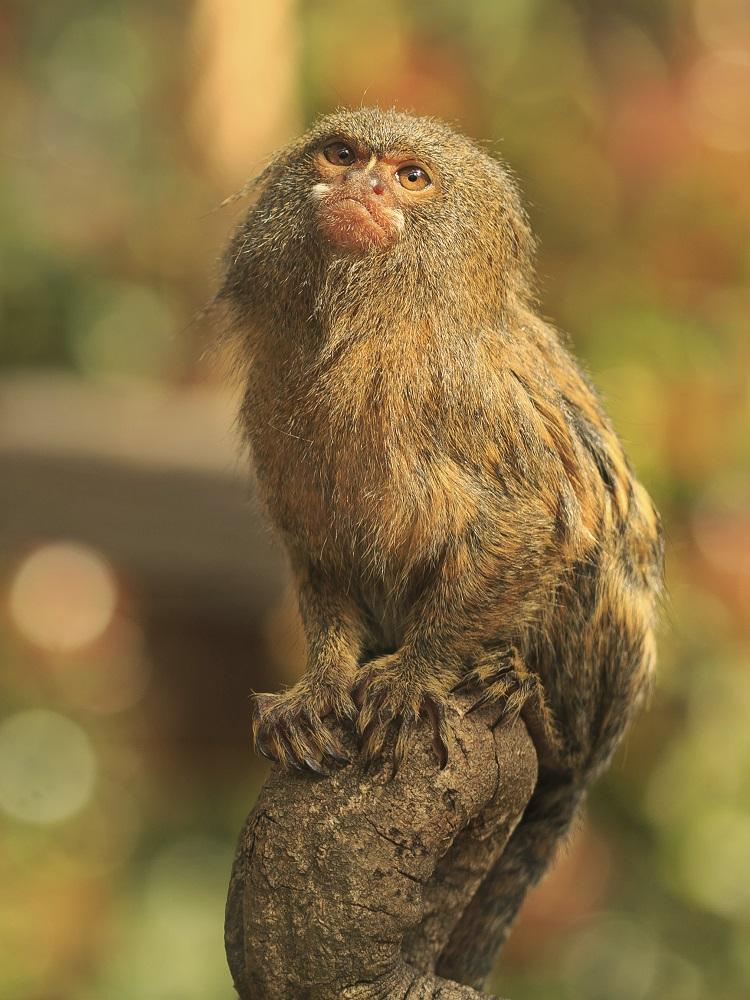Pygmy marmoset
The pygmy marmoset, scientifically known as Cebuella pygma.
Taxonomic classification:
- Kingdom: Animalia (Animals)
- Phylum: Chordata (Chordates)
- Class: Mammalia (Mammals)
- Order: Primates (Primates)
- Family: Callitrichidae (New World Monkeys)
- Genus: Cebuella
- Species: Cebuella pygmaea
Physical Characteristics:
1. Size: Pygmy marmosets are among the smallest primates in the world. They have a head and body length of about 4.6 to 6.2 inches (12 to 16 centimeters).
2. Weight: On average, pygmy marmosets weigh between 3 to 5 ounces (85 to 140 grams). This makes them incredibly lightweight.
3. Fur: They possess soft and dense fur that serves as protection against the often humid and wet rainforest environment.
4. Tail: Pygmy marmosets have a long, non-prehensile tail, which means it cannot grasp objects or branches like a monkey with a prehensile tail (like spider monkeys or howler monkeys).
6. Facial Features: Pygmy marmosets have relatively large eyes, which are adapted for their nocturnal and crepuscular (active at dawn and dusk) behavior. Their ears are small and rounded.
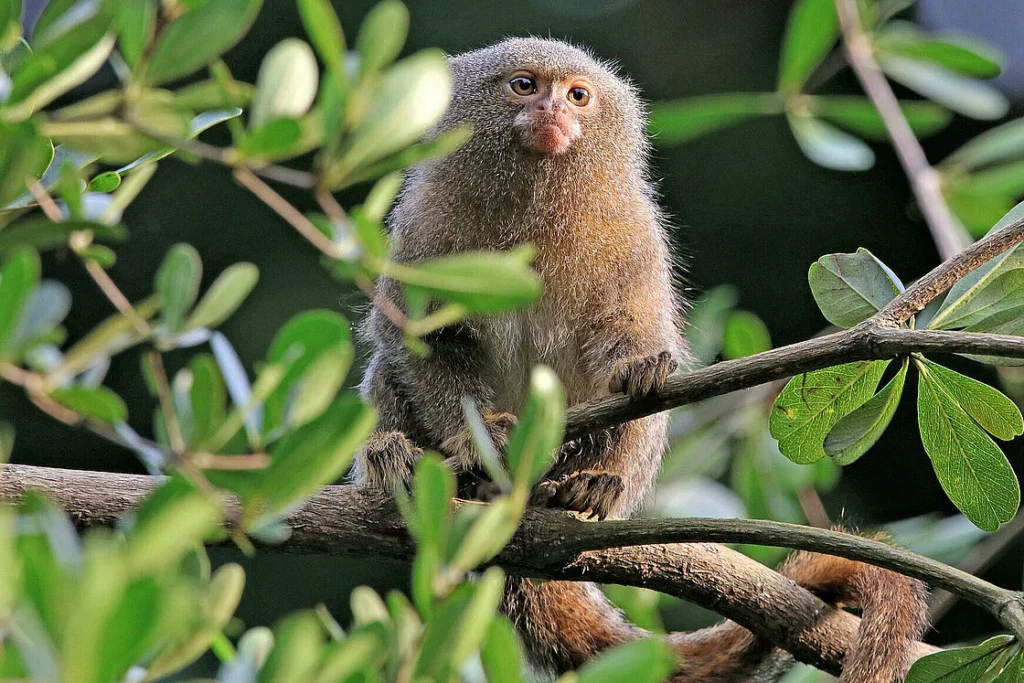
2. Range and Habitat:
Range:
Pygmy marmosets (Cebuella pygmaea) are primarily found in the rainforests of South America. Their range spans several countries in the Amazon Basin and surrounding areas, including:
- Brazil: They are found in the Amazon rainforest regions of Brazil, including the states of Amazonas, Acre, Rondônia, and parts of Pará.
- Colombia: Pygmy marmosets are also present in the western and southern parts of Colombia.
- Ecuador: They can be found in the eastern lowland rainforests of Ecuador.
- Peru: Their range extends into the Peruvian Amazon, particularly in the northeastern part of the country.
- Bolivia: Pygmy marmosets are known to inhabit certain areas of northern Bolivia.
Habitat:
Pygmy marmosets are highly adapted to life in the tropical rainforests of South America, and they have specific habitat requirements:
- Tropical Rainforests: They are predominantly found in the dense, lush tropical rainforests of the Amazon Basin, which provide them with abundant food sources and the protection of a dense canopy.
- Arboreal Lifestyle: Pygmy marmosets are arboreal creatures, which means they spend their lives in trees. They are exceptionally agile and can leap from branch to branch with ease. Their long tail helps with balance as they navigate the treetops.
- Tree Gums and Sap: These primates have specialized adaptations for feeding on tree gum and sap. They use their sharp claws to gouge holes in tree bark, which allows the gum to ooze out. They then lick up the gum for sustenance.
- Canopy Dwellers: Pygmy marmosets primarily inhabit the canopy of the rainforest, where they move quickly and communicate using vocalizations to maintain contact with their family groups.
- Nocturnal and Crepuscular: They are often active during the night and at dawn or dusk, which helps them avoid some of the rainforest’s daytime predators and forage for their preferred food sources.
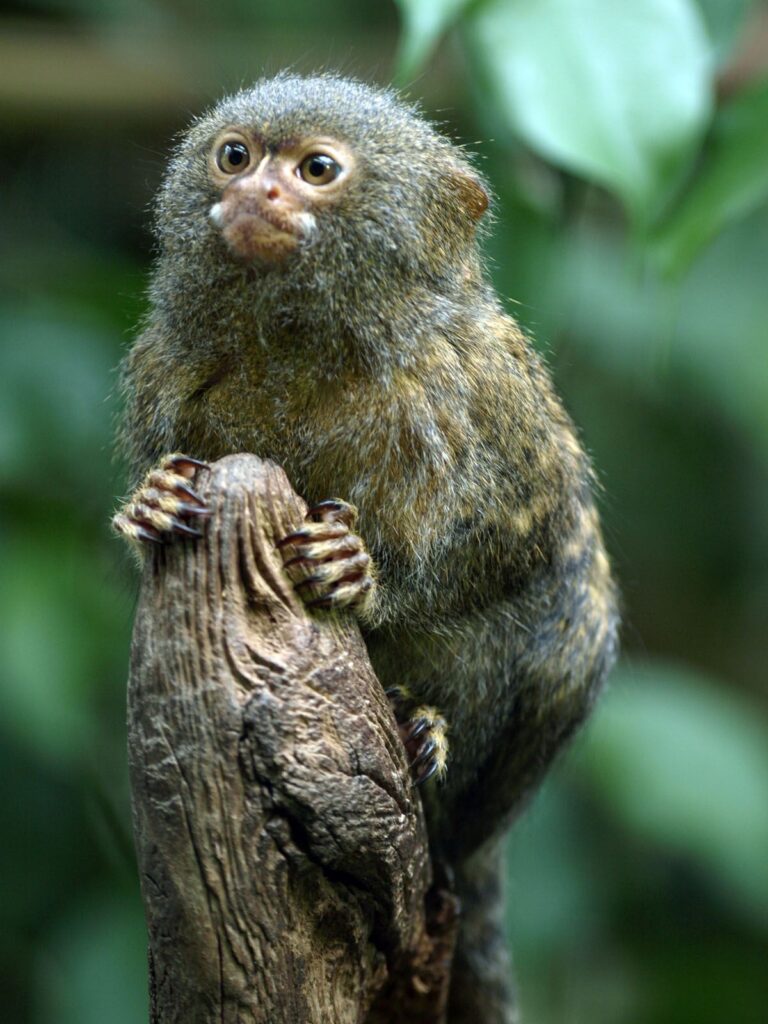
3. Behavior:
1. Social Structure:
- Pygmy marmosets are highly social animals and typically live in small family groups called troops.
- These troops usually consist of 2 to 6 individuals, including an adult breeding pair and their offspring.
2. Vocalizations:
- Pygmy marmosets communicate through a wide range of vocalizations, including whistles, trills, clicks, and chattering sounds.
- These vocalizations are used for various purposes, such as maintaining contact within the group, signaling danger, and marking territory.
3. Feeding Behavior:
- Pygmy marmosets are primarily omnivorous, and their diet is quite diverse.
- Their preferred food sources include tree gum and sap, fruit, insects, spiders, small vertebrates, and nectar from flowers.
- They have specialized adaptations, including sharp claws and elongated fingers, which allow them to access gum from trees by gouging holes in the bark.
- They use their long tongues to lap up the flowing gum.
4. Arboreal Lifestyle:
- As arboreal animals, pygmy marmosets spend the majority of their lives in the trees and are highly adapted for this lifestyle.
- Their small size and lightweight build make them well-suited for life in the treetops.
5. Reproduction and Parenting:
- Pygmy marmosets breed throughout the year, and the dominant female in a troop typically gives birth to twins, although singletons and occasional triplets can occur.
- Both parents and sometimes older siblings are involved in caring for the infants. They take turns carrying and grooming the young.
6. Nocturnal and Crepuscular Activity:
- Pygmy marmosets are primarily nocturnal and crepuscular, meaning they are most active during the night and at dawn or dusk.
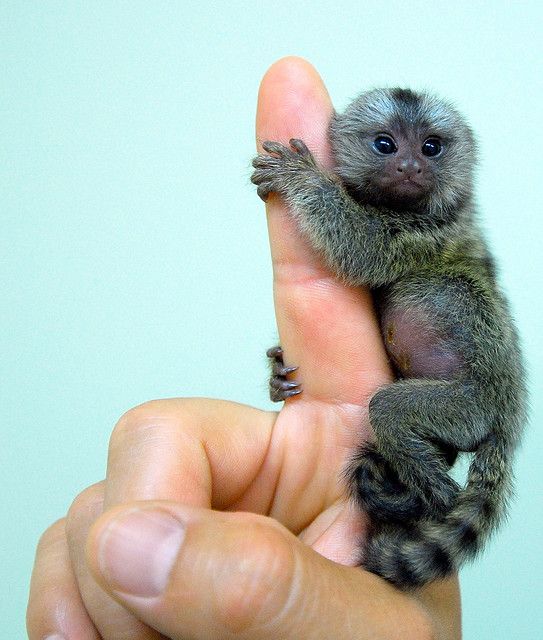
4. Reproduction:
1. Breeding Season:
- Pygmy marmosets do not have a strict breeding season and can reproduce throughout the year. This flexibility in breeding is advantageous in the unpredictable rainforest environment, where food availability can vary.
2. Reproductive Maturity:
- Female pygmy marmosets typically reach sexual maturity at around 8 to 12 months of age.
- Male pygmy marmosets become sexually mature a bit later, at around 12 to 15 months of age.
3. Mating and Gestation:
- Mating pairs within a family group are usually monogamous, meaning they form long-term bonds with a single mate.
- The dominant female in the group is the primary breeder, and she will mate with the dominant male.
- After mating, the female has a gestation period of approximately 4.5 to 5 months (around 140 to 150 days).
4. Birth and Offspring:
- Pygmy marmosets typically give birth to twins, although single births and occasional triplets can occur.
- The infants are born relatively undeveloped, and they are highly dependent on their parents and other group members for care and protection.
- Newborns are tiny, weighing only about 15-20 grams at birth, and they have a distinctive orange tint to their fur, which fades as they grow older.
- The mother carries the infants on her belly and may transfer them to the father or other group members for care.
- Cooperative parenting is a key feature of pygmy marmoset social structure, with all group members helping to care for and carry the infants.
5. Lifespan:
- In the wild, the average lifespan of pygmy marmosets is estimated to be around 6 to 9 years.
- In captivity, they can live longer, with lifespans of up to 15 years or more, provided they receive proper care.
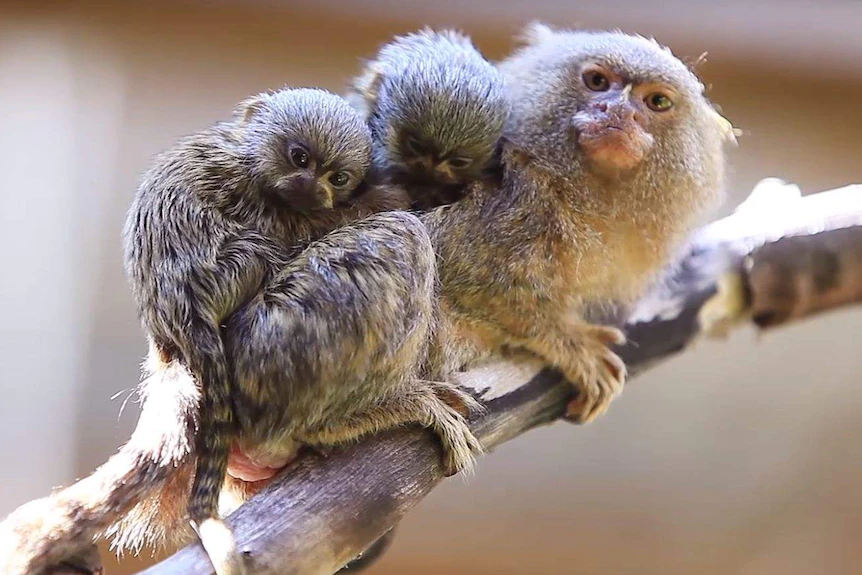
5. Conservation Status:
Conservation Status:
- Least Concern: The “Least Concern” classification implies that, at that time, pygmy marmosets were not considered to be facing an imminent risk of extinction. Their populations were believed to be relatively stable across their range.

Threats:
- Habitat Destruction: One of the primary threats to pygmy marmosets is habitat destruction due to deforestation. The expansion of agriculture, logging, and infrastructure development in the Amazon rainforest has led to the loss and fragmentation of their natural habitat.
- Illegal Pet Trade: Pygmy marmosets have sometimes been captured and sold in the illegal pet trade. This not only harms wild populations but also poses ethical and health concerns for the animals themselves, as they have specialized dietary and social needs that are difficult to meet in captivity.
- Climate Change: Climate change can have indirect effects on pygmy marmosets by altering their forest habitat and potentially affecting the availability of their food sources and increasing the frequency and severity of extreme weather events.
- Hunting: In some regions, pygmy marmosets may be hunted for their fur or as a source of bushmeat. However, this threat is generally less significant than habitat loss.
Conservation Efforts:
Efforts to conserve pygmy marmosets and their habitat include:
- Protected Areas: Establishing and maintaining protected areas and national parks within their range to safeguard their natural habitat.
- Research and Monitoring: Conducting research on pygmy marmoset populations to better understand their biology and behavior, and monitoring their populations to assess trends and threats.
- Anti-Poaching Measures: Implementing anti-poaching measures to deter illegal hunting and the pet trade.
- Raising Awareness: Educating local communities, policymakers, and the public about the importance of conserving pygmy marmosets and the biodiversity of the Amazon rainforest.
- Habitat Restoration: Supporting reforestation and habitat restoration initiatives in areas where habitat has been degraded.
Some interesting fact about pygmy marmoset:
- Smallest Primates: Pygmy marmosets are often called the world’s smallest primates due to their diminutive size, with an average length of about 4.6 to 6.2 inches (12 to 16 centimeters).
- Tiny Offspring: Newborn pygmy marmosets are incredibly small, weighing only about 15-20 grams (0.5-0.7 ounces), which is roughly the weight of a AAA battery.
- Gum Feeding: They are specialized gum-feeders, and their diet primarily consists of tree gum, sap, and resin. They use sharp teeth to gouge holes in tree bark and then lick up the oozing gum.
- Multiple Births: Pygmy marmosets usually give birth to twins, but they can also have singletons or occasionally triplets. This is relatively unusual among primates.
- Short Lifespan: In the wild, pygmy marmosets have an average lifespan of around 6 to 9 years. However, they can live longer in captivity, with some individuals reaching 15 years or more.
